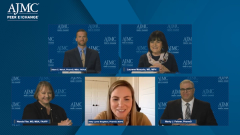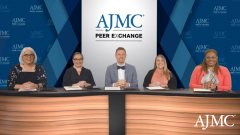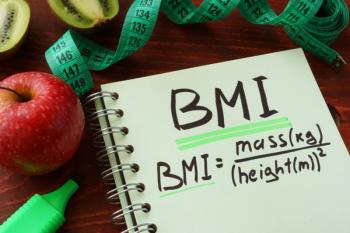
Overview of Current Vaccine Landscape
The panel measures the significance of an RSV vaccine in relation to other vaccines in circulation.
Episodes in this series

Wanda Filer, MD, MBA, FAAFP: One of the questions I had for these 20 medical directors is; your patients have 2 arms. Now in an adult, if you think about it, we’ve got the flu, COVID-19, RSV [respiratory syncytial virus] potentially, and pneumococcal and shingles vaccines. What do you do, and how will you prioritize those? It was very interesting to me to hear the response. Everybody was all in on the flu vaccine. “Got it, understand.” There is a sense that as we also see the COVID-19 vaccine go into more of the commercial sector now, that some of those patients who’ve been holding out and not getting their vaccine, and they’re in their medical home and they’ve got a relationship with a trusted clinician, maybe we can convince some of those folks that it’s time to get a COVID-19 vaccine.
RSV is the new kid on the block in particular. So again, the medical community needs to understand the safety profiles. They need to understand the duration. When I’ve said to them this has been years in the making, to your point, that gave some peace of mind. I think it will hopefully do so for the public as well. But the public will need to understand that the shingles vaccine they can give at any time. The pneumococcal vaccine doesn’t have to be administered necessarily every fall, but there are definitely 2 arms and 3 seasonal vaccines.
One of the things we don’t know yet is what can we coadminister? What do we need to stagger? There’s a lot of information yet to be determined. I think the other big part of this is to make sure that it’s paid for. That the vaccine, if it’s going to be out and we’re going to offer it to patients, patients are very cost sensitive these days. We need to make sure that it’s paid for for them because this can save lives and save money.
Marty J. Feltner, PharmD: That was the other obstacle I was going to talk about as well, the coverage. If it’s going to go through Medicare Part D, then there’s going to be a co-pay essentially to the resident or the patient, right?I mean Part B, as in boy, I apologize. There could be, but Part B there wouldn’t be. We need to determine which route is going to be covered.
Wanda Filer, MD, MBA, FAAFP: As of January of this year, Part D co-pays have gone away.
Laurene Mascola, MD, MPH: There’s the Inflation Reduction Act. All of that.
Wanda Filer, MD, MBA, FAAFP: All the Part D co-pays, fortunately, have gone away as of January 2023, thank heavens.
Laurene Mascola, MD, MPH: I’ve heard that for the RSV vaccine, should it go forward, it’s Part D, with maybe some inference of it being both Part B and D.
Wanda Filer, MD, MBA, FAAFP: There are a lot of us advocating for Parts B and D, but time will tell.
Laurene Mascola, MD, MPH: But with Part D, there is the Inflation Reduction Act. I think the other important thing too, with respect to the education component, again public health has to come to the table and start counting the disease so it can inform the public of what the burden is. Because as you said before, we always talk about the babies and the need to get them with the monoclonal antibodies. But we haven’t yet really informed the public of the significance of how many people get sick with RSV, get hospitalized, use our health care dollars, and we eventually might have case fatality rates. Again, public health has to demonstrate that burden of disease such that we believe it’s important to vaccinate. We’ve demonstrated that with pneumonia, we’ve looked at it again with influenza. We look at ILI [influenza-like illness], and again, RSV is part of that. But we have to delineate that so it’s in people’s minds.
Wanda Filer, MD, MBA, FAAFP: I think as you get families together and you remember that those babies right there who are ages 2 and under are highly likely to get RSV at least once in those 2 years, they bring it over to grandma and grandpa’s house. Grandma and grandpa then get sick, they go to the grocery store, they do some activity. They pick up RSV. They may think of it as a little cold. The next thing you know, they not intentionally have infected others.
This is a ubiquitous virus out in the community. We need to recognize the consequences for populations on both ends of the spectrum, and recognize that it doesn’t have to be this way. If we’ve got a safe way to protect people, we do this for the flu vaccine. It’s incredibly important, we can save lives. We can do the same thing here.
Adam C. Welch, PharmD, MBA, FAPhA: If we can prevent the disease in one population, it will carry over and provide prevention in other populations. Let’s talk a bit about immunosenescence. You mentioned that as we age, our immune system weakens.
Laurene Mascola, MD, MPH: That’s correct.
Adam C. Welch, PharmD, MBA, FAPhA: When you look at vaccine recommendations in this country, they’re either age-based, if you’re a certain age, you need to get the vaccine, or they’re based on certain high-risk conditions. We mentioned some of the conditions that are of concern for RSV: heart conditions, chronic lung conditions, COPD [chronic obstructive pulmonary disease], asthma, for example. But people, based on age, should be thinking about this vaccine.
Laurene Mascola, MD, MPH: Right. As I said, once you hit the age of 65, you might still think you can climb Mount Everest or run a marathon. But unfortunately, your T and B cells have decreased in number and function. We are seeing an increased risk for people over the age of 65, which is now the new 55, who feel great and want to do all these things, but unfortunately, their immune system is still on the decline. Again, we are more susceptible to various viral infections and bacterial infections, and we need to protect ourselves against these diseases with available vaccines and/or prophylactic treatments.
Adam C. Welch, PharmD, MBA, FAPhA: It sounds like it’s just as much about keeping you healthy as a person who may get the vaccine as it is about keeping the people you’re going to interact with healthy, particularly the infants we had mentioned as well.
Laurene Mascola, MD, MPH: That follows the COVID-19 model. We’ve always been talking about vaccinating children and other people so they don’t bring it home to grandma and grandpa. I think we can use that same piece of information, which we haven’t done because there hasn’t been a vaccine for people against RSV. As we said before, almost everyone by the age of 2 does get an RSV infection, and they can bring it back home to grandma or grandpa, who might be at more risk because of their age or underlying comorbidities.
Wanda Filer, MD, MBA, FAAFP: I’m going to flip that a bit and say we’ve been doing pertussis vaccines. We’ve been giving pertussis boosters in grandparents before they go and see their new grandchildren because, God forbid, you infect that baby when they’re particularly vulnerable. I find grandparents very receptive to making sure they don’t get pertussis because I’ve seen that one as well. This is the same thought process, that you’re going to protect the people you love. You’re going to protect yourself, your family, your community. And the RSV vaccine can do that.
Adam C. Welch, PharmD, MBA, FAPhA: That’s a great point. You mentioned pertussis, the Tdap [tetanus, diphtheria, pertussis] vaccine is also recommended for every pregnancy to provide the antibodies so it can protect the infant before their immune systems can fight off any infection on their own.
Dr Singleton, RSV infections, is this something we need to worry about year-round, or is it seasonal?
Abby Lynne Singleton, PharmD, BCPS: RSV typically causes annual outbreaks of respiratory illness. In most regions of the United States, RSV starts circulating in the fall and usually peaks in the winter. But the timing and severity of RSV season can vary from year to year, especially like we’ve discussed with COVID-19. With everybody wearing their face masks and social distancing, that made the RSV season not be the typical season that it was. But like you were talking about earlier, I think they are predicting that it will go back to more of a fall-winter virus.
Adam C. Welch, PharmD, MBA, FAPhA: We’re looking at RSV around the same time frame that we’re looking at influenza. We can’t really think about COVID-19 because things were different during the COVID-19 pandemic. Now we have multiple upper respiratory-type infections that are happening at the same time.
Transcript edited for clarity.
Newsletter
Stay ahead of policy, cost, and value—subscribe to AJMC for expert insights at the intersection of clinical care and health economics.
















































